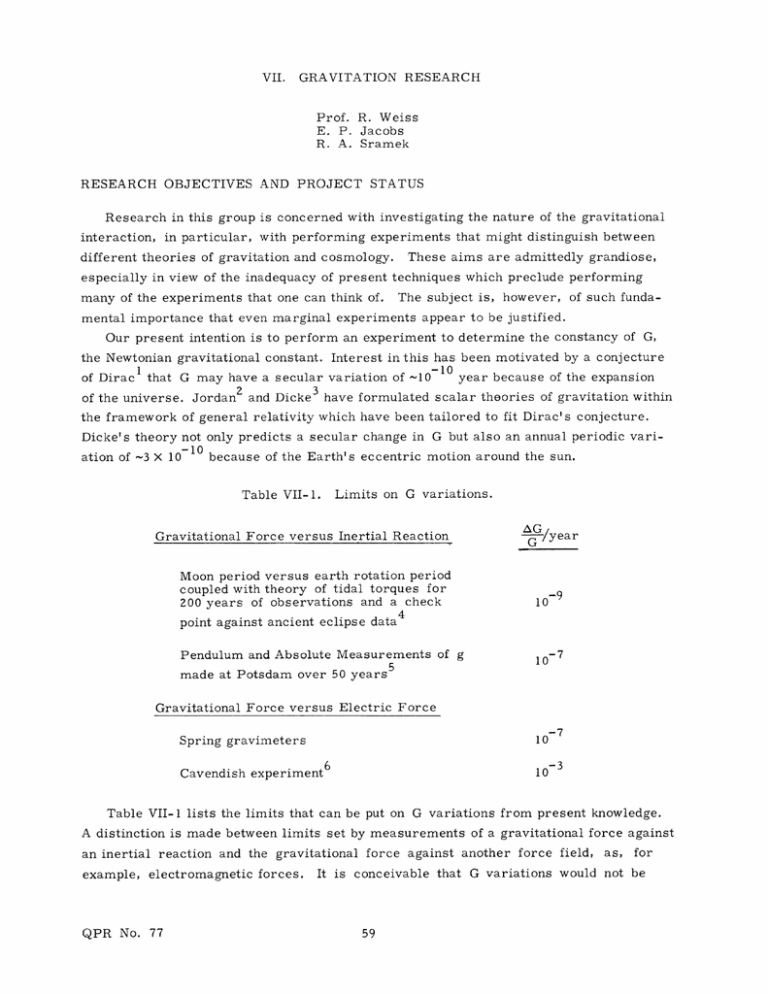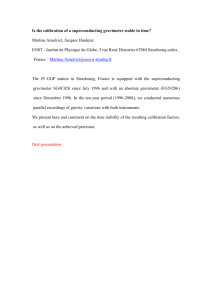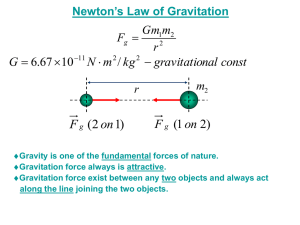Prof. R. Weiss
advertisement

VII. GRAVITATION RESEARCH Prof. R. Weiss E. P. Jacobs R. A. Sramek RESEARCH OBJECTIVES AND PROJECT STATUS Research in this group is concerned with investigating the nature of the gravitational in particular, with performing experiments that might distinguish between interaction, These aims are admittedly grandiose, different theories of gravitation and cosmology. especially in view of the inadequacy of present techniques which preclude performing many of the experiments that one can think of. The subject is, however, of such funda- mental importance that even marginal experiments appear to be justified. Our present intention is to perform an experiment to determine the constancy of G, the Newtonian gravitational constant. Interest in this has been motivated by a conjecture of Dirac that G may have a secular variation of ~10-10 year because of the expansion of the universe. Jordan 2 and Dicke 3 have formulated scalar theories of gravitation within the framework of general relativity which have been tailored to fit Dirac's conjecture. Dicke's theory not only predicts a secular change in G but also an annual periodic vari-10 because of the Earth's eccentric motion around the sun. ation of ~3 X 10 Limits on G variations. Table VII-1. Gravitational Force versus Inertial Reaction Moon period versus earth rotation period coupled with theory of tidal torques for 200 years of observations and a check -/year 10 -9 point against ancient eclipse data 4 Pendulum and Absolute Measurements of g 5 made at Potsdam over 50 years 10 - 7 Gravitational Force versus Electric Force 10-7 Spring gravimeters Cavendish experiment 6 10-3 Table VII-1 lists the limits that can be put on G variations from present knowledge. A distinction is made between limits set by measurements of a gravitational force against an inertial reaction and the gravitational force against another force field, example, electromagnetic forces. QPR No. 77 It is as, for conceivable that G variations would not be (VII. GRAVITATION RESEARCH) observed in the first class of observations. The table is not exhaustive, studies of G variations as they might affect stellar evolution and the chronology of the Earth's history made by Dicke 7 and Jordan 8 do not offer smaller limits than those given in Table VII- 1. Proposed Experiment The experiment that we propose is to measure variations in g, the Earth's gravitational attraction at the surface, with a stable gravimeter of a new design. Although the proposed method has the advantage that it measures a gravitational force against an electric force, it introduces the serious problem of the Earth's stability which will be disAll previous gravimeters employ Hooke's law forces in solids or gas cussed presently. pressure to balance the gravitational force on a mass. Measurements of g made with gas gravimeters fall in the first class, and are extremely temperature-sensitive. Spring gravimeters are troubled by temperature dependence of the Young's modulus of the spring Ag -6 -10 /oC), and in a much more g -8 sinister manner by random material creeps of the springs (Ag/g ~ 10 - 8 month). In the material (the best give a temperature dependence proposed gravimeter (shown in Fig. VII-1) the spring is replaced by a measurable electric force and is fundamentally an inverted Kelvin absolute electrometer. I MOLECULAR BEAM I T 1 I 2 rf dc 3 dc Plate 1 is the I dc rf 3 1 mg Fig. VII-1. Proposed gravimeter. gravitating mass, which is supported vertically by the electric field DC and maintained horizontally by the fringing field between the guard plate 3 and the gravitating plate. The position of plate 1 is established interferometrically; the interferometer is incorporated in a null-seeking servomechanism which controls 6DC to maintain plate 1 co-planar with the guard plates. = mg= F e where The servo maintains the relation 8r 2 DC A, p DCp is the average of the square of the electric field over the surface, A, DCp QPR No. 77 (VII. of plate 1. In order to measure DCp the gravimeter GRAVITATION RESEARCH) plates are incorporated in the transition region of a molecular beam electric resonance apparatus. AJ = 0, Dm = +l Stark transitions in a polar molecule are induced in separated regions of 6RF between plates 1 and 2. If the Stark energies are small compared with the rotational energy of the molecule, the Stark transition frequency is given by vSTARK k 'DC>B' where 2 >B is the k is a function of the molecular constants and quantum numbers and average of the square of the electric field at the location of the molecular beam between DCp (which is not strictly so PL B = the regions of 6 RF Assuming that because of the fringing field and, for only one molecular beam, because of nonparallelism of the plates) we can save the force equation and get VSTARK 8k A mg. If m and A are constant, the g measurement becomes a frequency measurement Ag =_A g v This rudimentary description of the gravimeter only alludes to a host of problems which must be investigated first. Among these are: 1. Constancy of the gravitating mass and temperature dependence of the plate area. 2 >B. In particular, how does the relation vary with plate separation, tilt, and co-planarity of the gravitating plate and the guard plates? An experiment is now in progress to study these effects for various plate 2. Constancy of the relation between Fe and geometries and potential distributions. 3. Field homogeneity conditions necessary to see a resonance. Inhomogeneitics can arise from nonparallelism of the plates and the time dependence of ground noise. For example, it may be necessary to have a fast AC servo to hold the plate, and hence DC, steady over the integration time of the servo that scans the resonance. Stability of the Earth Although no measurements have been reported of changes in g at a fixed point on the Earth (besides calculable and known effects such as the tides), it is likely that they exist, especially within the precision demanded for this experiment. In principle, the only multipole moment of the Earth's gravitational potential whose changes are not amenable to averaging over distributed gravimeter sites is the monopole. A catalogue of the mass changes that one can think of would yield as the largest contribution Ag/g ~ 10-16/year from meteor influx. Estimates of changes in the Earth's radius are far more influential. Again, there are no measurements, and some theories predict 10 are exponents of expansion, and others, contraction. Jeffreys,9 and MacDonald QPR No. 77 (VII. GRAVITATION RESEARCH) contraction caused by cooling which would result in changes in radius producing A~ +10 - 0 -1013 per year. Egyed calculates for an expansion, together with cong Ag 0 -10 tinental drift, a change in radius that could result in a g -10 per year. To emphag size this sensitivity, one need only observe that a change of 0. 3 mm in the radial position of the gravimeter corresponds to a Ag -10 g ~ 10 g One change in the quadrupole moment can already be anticipated. polar ice caps results in a Ag - 10 -i0 300 latitude. The melting of the per year at 45 latitude; however, it is zero at g Variations in the Earth's rotation rate are monitored to the precision 0 necessary for the experiment. Besides the Earth's radius, the other major unknowns are the magnitudes of local distortions and mass redistributions in the vicinity of a given site (the very high order multipole moments). Knowledge of this will set a limit on the number of sites necessary to establish a statistical estimate of the global g variation. We would endeavor, course, to pick seismically inactive rock shields with small gravity anomalies. of To our knowledge, the only measurements of secular earth distortion (except in regions of postglacial uplift) have been made by the Benioff Strain seismometer at the Lamont Geophysical Laboratory site, in Ogdensberg, New Jersey, where a limit of At < 10 -8 /month 12 over a 200-ft length has been set. It appears, however, that the limit is instrumental. In order to have a handle on radius changes and to correlate local distortions with changes in g, it would be useful to have a stable strain seismometer associated with the gravimeter. We are, at present, engaged in the design and construction of a stabilized laser strain seismometer. Another necessary instrument is a stable tiltmeter, since the gravimeter is quadratically dependent on the angle between the plumb and the normal to the gravitating plate. This instrument is being constructed as part of senior thesis research. Our first effort will be to build one gravimeter and search for the annual periodic change in g predicted by Dicke's scalar theory. R. Weiss References 1. 2. 1955). 3. P. A. M. Dirac, Proc.Roy. Soc. (London) A165, 199 (1938). P. Jordan, Schwerkraft und Weltall (Friedrich Vieweg und Sohn, Braunschweig, C. Grans and R. H. Dicke, Phys. Rev. 124, 1925 (1961). 4. W. H. Munk and G. J. F. MacDonald, The Rotation of the Earth (Cambridge University Press, London, 1960). 5. G. P. Woollard, Advances in Geophysics, Vol. 1, p. 281, 6. F. H. Newman and V. H. L. Searle, The General (Edward Arnold Ltd., London, 5th edition, 1957). 7. R. H. Dicke, Rev. Modern Phys. 34, 110 (1962). QPR No. 77 1952. Properties of Matter (VII. 8. 9. 1962). P. Jordan, Naturwiss. H. Jeffreys, F. 10. G. J. 11. L. Egyed, 48, 417 (1961). The Earth (Cambridge University Press, London, 4th edition, MacDonald, Nature 178, 12. M. W. Major, Am. 54, 295 (1964). QPR No. 77 GRAVITATION RESEARCH) Revs. Geophys. 1, 587 (1963). 534 (1956). G. H. Sutton, U. Oliver, and R. Metsger, Bull. Seismol. Soc.




